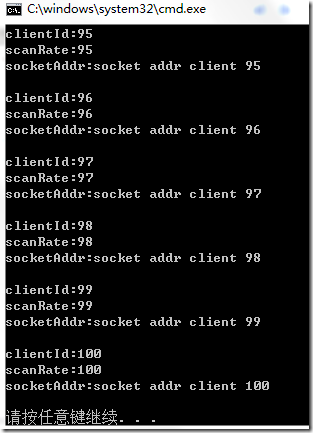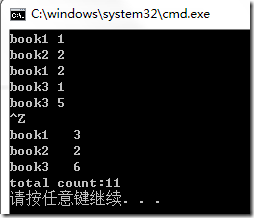C++ Internals: STL之Map
概述
Map是标准关联式容器(associative container)之一,一个map是一个键值对序列,即(key ,value)对。它提供基于key的快速检索能力,在一个map中key值是唯一的。map提供双向迭代器,即有从前往后的(iterator),也有从后往前的(reverse_iterator)。
map要求能对key进行<操作,且保持按key值递增有序,因此map上的迭代器也是递增有序的。如果对于元素并不需要保持有序,可以使用hash_map。
map中key值是唯一的,如果马匹中已存在一个键值对(昵称,密码):("skynet",407574364),而我们还想插入一个键值对("skynet",472687789)则会报错(不是报错,准确的说是,返回插入不成功!)。而我们又的确想这样做,即一个键对应多个值,幸运的是multimap可是实现这个功能。
下面我们用实例来深入介绍map、multimap,主要内容如下:
- 1、例子引入
- 2、map中的类型定义
- 3、map中的迭代器和键值对
- 4、map中的构造函数与析构函数
- 5、map中的操作方法
- 6、再议map的插入操作
- 7、[]不仅插入
- 8、multimap
- 9、总结
1、例子引入
有一个服务器manager维护着接入服务器的client信息,包括clinetId、scanRate、socketAddr等等。我们定义一个结构体保存scanRate、socketAddr信息。如下:
1 |
typedef int clientId; |
2 |
typedef struct{ |
3 |
int scanRate; |
4 |
string socketAddr; |
5 |
}clientInfo; |
我们用map保存这些信息:clientId为键key,clientInfo为值。这样我们可以通过clientId快速检索到client的相关信息,我们可以这样定义:
1 |
map<clientId,clientInfo> clientMap; |
这样我们定义了一个clientMap,如果我们要定义多个这样的map,需要多次写map<clientId,clientInfo> 变量名。为了避免这样情况,我们通常为map<clientId,clientInfo>定义个别名,如:
1 |
typedef map<clientId,clientInfo> clientEdp; |
2 |
clientEdp clientMap; |
之后我们就可以像定义clientMap一样定义map<clientId,clientInfo>对象,这样的好处还有:如果我们需要修改map的定义,只需要在一处修改即可,避免修改不彻底造成的不一致现象。
我们这就完成了需要的map的定义,如果不定义或没有在它上面的操作的话,就像定义类而没有方法一样,意义不大或毫无意义。幸运的是,STL提供了这些常用操作:排序(注:map是不能也不要排序的,因为map本身已经排好序了)、打印、提取子部分、移除元素、添加元素、查找对象,就像数据库的增删改查操作!现在我们详细介绍这些操作,并逐步引入hash_map、multimap。
2、map中的类型定义
关联数组(associative array)是最有用的用户定义类型之一,经常内置在语言中用于文本处理等。一个关联数组通常也称为map,有时也称字典(dictionary),保存一对值。第一个值称为key、第二个称为映射值mapped-value。
标准map是定义在std命名空间中的一个模板,并表示为<map>。它首先定义了一组标准类型名字:
01 |
template<class Key,class T,class Cmp=less<key>, |
02 |
class A=allocator<pair<const Key,T>> |
03 |
class std::map |
04 |
{ |
05 |
public: |
06 |
//types |
07 |
typedef Key key_type; |
08 |
typedef T mapped_type; |
09 |
|
10 |
typedef pair<const Key,T> value_type; |
11 |
|
12 |
typedef Cmp key_compare; |
13 |
typedef A allocator_type; |
14 |
|
15 |
typedef typename A::reference reference; |
16 |
typedef typename A::const_reference const_reference; |
17 |
|
18 |
typedef implementation_define1 iterator; |
19 |
typedef implementation_define2 const_iterator; |
20 |
|
21 |
typedef typename A::size_type size_type; |
22 |
typedef typename A::difference_type difference_type; |
23 |
|
24 |
typedef std::reverse_iterator<iterator> reverse_iterator; |
25 |
typedef std::reverse_iterator<const_iterator> const_reverse_iterator; |
26 |
//... |
27 |
} |
注意:map的value_type是一个(key,value)对,映射值的被认为是mapped_type。因此,一个map是一个pair<const Key,mapped_type>元素的序列。从const Key可以看出,map中键key是不可修改的。
不得不提的是map定义中Cmp和A都是可选项。Cmp是定义在元素之间的比较方法,默认是<操作;A即allocator用来分配和释放map总键值对所需使用的内存,没有指定的话即默认使用的是STL提供的,也可以自定义allocator来管理内存的使用。多数情况,我们不指定这两个选项而使用默认值,这样我们定义map就像下面这样:
1 |
map<int,clientInfo> clientMap; |
Cmp和A都缺省。 通常,实际的迭代器是实现定义的,因为map很像使用了树的形式,这些迭代器通常提供树遍历的某种形式。逆向迭代器是使用标准的reverse_iterator模板构造的。
3、map中的迭代器和键值对
map提供惯常的返回迭代器的一组函数,如下所示:
01 |
template<class Key,class T,class Cmp=less<key>, |
02 |
class A=allocator<pair<const Key,T>> |
03 |
class std::map |
04 |
{ |
05 |
public: |
06 |
//... |
07 |
//iterators |
08 |
iterator begin(); |
09 |
const_iterator begin() const; |
10 |
|
11 |
iterator end(); |
12 |
const_iterator end() const; |
13 |
|
14 |
reverse_iterator rbegin(); |
15 |
const_reverse_iterator rbegin() const; |
16 |
|
17 |
reverse_iterator rend(); |
18 |
const_reverse_iterator rend() const; |
19 |
//... |
20 |
} |
map上的迭代器是pair<const Key,mapped_type>元素序列上简单的迭代。例如,我们可能需要打印出所有的客户端信息,像下面的程序这样。为了实现这个,我们首先向《例子引入》中定义的clientEdp中插入数据,然后打印出来:
01 |
#include<iostream> |
02 |
#include<map> |
03 |
#include<string> |
04 |
using namespace std; |
05 |
|
06 |
typedef int clientId; |
07 |
typedef struct{ |
08 |
int scanRate; |
09 |
string socketAddr; |
10 |
}clientInfo; |
11 |
|
12 |
int main(int argc,char** argv) |
13 |
{ |
14 |
typedef map<clientId,clientInfo> clientEdp; |
15 |
typedef map<clientId,clientInfo>::const_iterator iterator; |
16 |
|
17 |
clientEdp clients; |
18 |
clientInfo client[100]; |
19 |
char str[10]; |
20 |
string strAddr("socket addr client "); |
21 |
|
22 |
for(int i=0;i<100;i++) |
23 |
{ |
24 |
client[i].scanRate=i+1; |
25 |
//convert int to char* |
26 |
itoa(i+1,str,10); |
27 |
//concatenate strAddr and str |
28 |
client[i].socketAddr=strAddr+str; |
29 |
cout<<client[i].socketAddr<<endl; |
30 |
clients.insert( |
31 |
make_pair(i+1,client[i])); |
32 |
} |
33 |
delete str; |
34 |
for(iterator i=clients.begin();i!=clients.end();i++) |
35 |
{ |
36 |
cout<<"clientId:"<<i->first<<endl; |
37 |
cout<<"scanRate:"<<i->second.scanRate<<endl; |
38 |
cout<<"socketAddr:"<<i->second.socketAddr<<endl; |
39 |
cout<<endl; |
40 |
} |
41 |
} |
一个map迭代器以key升序方式表示元素,因此客户端信息以cliendId升序的方式输出。运行结果可以证明这一点,运行结果如下所示:
图1、程序运行结果
我们以first引用键值对的key,以second引用mapped value,且不用管key和mapped value是什么类型。其实pair在std的模板中是这样定义的:
01 |
template <class T1,class T2>struct std::pair{ |
02 |
typedef T1 first_type; |
03 |
typedef T2 second_type; |
04 |
|
05 |
T1 first; |
06 |
T2 second; |
07 |
|
08 |
pair():first(T1()),second(T2()){} |
09 |
pair(const T1& x,const T2& y):first(x),second(y){} |
10 |
template<class U,class V> |
11 |
pair(const pair<U,V>& p):first(p.first),second(p.second){} |
12 |
} |
即map中,key是键值对的第一个元素且mapped value是第二个元素。pair的定义可以在<utility>中找到,pair提供了一个方法方便创建键值对:
1 |
template <class T1,class T2>pair<T1,T2> |
2 |
std::make_pair(const T1& t1,const T2& t2) |
3 |
{ |
4 |
return pair<T1,T2>(t1,t2); |
5 |
} |
上面的例子中我们就用到了这个方法来创建(clientId,clientInfo)对,并作为Insert()方法的参数。每个pair默认初始化每个元素的值为对应类型的默认值。
4、map中的构造函数与析构函数
map类惯常提供了构造函数和析构函数,如下所示:
01 |
template<class Key,class T,class Cmp=less<key>, |
02 |
class A=allocator<pair<const Key,T>> |
03 |
class std::map |
04 |
{ |
05 |
//... |
06 |
//construct/copy/destroy |
07 |
explicit map(const Cmp&=Cmp(),const A&=A()); |
08 |
template<class In>map(In first,In last, |
09 |
const Com&=Cmp(),const A&=A()); |
10 |
map(const map&); |
11 |
|
12 |
~map(); |
13 |
|
14 |
map& operator=(const map&); |
15 |
//... |
16 |
} |
复制一个容器意味着为它的每个元素分配空间,并拷贝每个元素值。这样做是性能开销是很大的,应该仅当需要的时候才这样做。因此,map传的是引用。
5、map中的操作方法
前面我们已经说过,如果map中仅定义了一些key、mapped value类型的信息而没有操作方法,就如定义个仅有字段的类意义不大甚至毫无意义。由此可见map中定义操作方法非常重要!前面的例子我们就用到了不少方法,如返回迭代器的方法begin()、end(),键值对插入方法insert()。下面我们对map中的操作方法做个全面的介绍:
01 |
template<class Key,class T,class Cmp=less<key>, |
02 |
class A=allocator<pair<const Key,T>> |
03 |
class std::map |
04 |
{ |
05 |
//... |
06 |
//map operations |
07 |
|
08 |
//find element with key k |
09 |
iterator find(const key_type& k); |
10 |
const_iterator find(const key_type& k) const; |
11 |
|
12 |
//find number of elements with key k |
13 |
size_type count() const; |
14 |
|
15 |
//find first element with key k |
16 |
iterator lower_bound(const key_type& k); |
17 |
const_iterator lower_bound(const key_type& k) const; |
18 |
|
19 |
//find first element with key greater than k |
20 |
iterator upper_bound(const key_type& k); |
21 |
const_iterator upper_bound(const key_type& k) const; |
22 |
|
23 |
//insert pair(key,value) |
24 |
pair<iterator,bool>insert(const value_type& val); |
25 |
iterator insert(iterator pos,const value_type& val); |
26 |
template<class In>void insert(In first,In last); |
27 |
|
28 |
//erase element |
29 |
void erase(iterator pos); |
30 |
size_type erase(const key_type& k); |
31 |
void erase(iterator first,iterator last); |
32 |
void clear(); |
33 |
|
34 |
//number os elements |
35 |
size_type size() const; |
36 |
|
37 |
//size of largest possible map |
38 |
size_type max_size() const; |
39 |
|
40 |
bool empty() const{return size()==0;} |
41 |
|
42 |
void swap(map&); |
43 |
//... |
44 |
} |
上面这些方法基本都能顾名思义(PS.由此可见,命名有多重要,我们平时要养成好的命名习惯,当然注释也必不可少!)。虽然已经非常清楚了了,但我还是想讲解一下以消除不惜要的误解和更好地应用这些方法。
- find(k)方法简单地返回键值为k的元素的迭代器;如果没有元素的键值为k,则返回map的end()迭代器。由于map是按键key升序排列,所有查找的复杂度只有O(logN)。因此,我们通常会这样用这个方法:
01#include<iostream>02#include<map>03#include<string>04usingnamespacestd;0506typedefintclientId;07typedefstruct{08intscanRate;09string socketAddr;10}clientInfo;1112intmain(intargc,char** argv)13{14typedefmap<clientId,clientInfo> clientEdp;15typedefmap<clientId,clientInfo>::const_iterator iterator;1617clientEdp clients;18clientInfo client[100];19char* str=newchar[10];20string strAddr("socket addr client ");2122for(inti=0;i<100;i++)23{24client[i].scanRate=i+1;25//convert int to char*26itoa(i+1,str,10);27//concatenate strAddr and str28client[i].socketAddr=strAddr+str;29clients.insert(30make_pair(i+1,client[i]));31}32deletestr;33<SPAN style="COLOR: #ff0000"> </SPAN><B><SPAN style="COLOR: #ff0000">clientId id=10;34iterator i=clients.find(id);35if(i!=clients.end()){36cout<<"clientId: "<<id37<<" exists in clients"<<endl;38}39else{40cout<<"clientId: "<<id41<<" doesn't exist in clients"<<endl;42}</SPAN></B>43} - insert()方法 试图将一个(Key,T)键值对加入map。因为键时唯一的,所以仅当map中不存在键值为k的键值对时插入才成功。该方法的返回值为pair<iterator,bool>,如果插入成功bool值为TRUE,iterator指向插入map中后的键值对。如下代码:
01#include<iostream>02#include<map>03#include<string>04usingnamespacestd;0506typedefintclientId;07typedefstruct{08intscanRate;09string socketAddr;10}clientInfo;1112intmain(intargc,char** argv)13{14typedefmap<clientId,clientInfo> clientEdp;15typedefmap<clientId,clientInfo>::const_iterator iterator;1617clientEdp clients;1819clientId id=110;20clientInfo cltInfo;21cltInfo.scanRate=10;22cltInfo.socketAddr="110";23pair<clientId,clientInfo> p110(id,cltInfo);24pair<iterator,bool> p=clients.insert(p110);25if(p.second){26cout<<"insert success!"<<endl;27}28else{29cout<<"insert failed!"<<endl;30}31//i points to clients[110];32iterator i=p.first;33cout<<i->first<<endl;34cout<<i->second.scanRate<<endl;35cout<<i->second.socketAddr<<endl;36}
上面我们看出,这里我们插入键值对是首先声明一个键值对pair<clientId,clientInfo> p110(id,cltInfo); 然后再插入,这个我们之前make_pair方法不一样,make_pair方法用的比较多。
- erase()方法用法比较简单,比如像清除clientId为110的键值对,我们只需要对clients调用erase方法:clients.erase(clients.find(110));或者我们想清除clientId从1到10的键值对,我们可以这样调用erase()方法:clients.erase(clients.finds(1),clients.find(10));简单吧!别得意,你还需要注意,如果find(k)返回的是end(),这样调用erase()方法则是一个严重的错误,会对map造成破坏操作。
6、再议map的插入操作
前面我们介绍了利用map的插入方法insert(),声明键值对pair或make_pair生成键值对然后我们可以轻松的将键值对插入map中。其实map还提供了更方便的插入操作利用下标(subscripting,[])操作,如下:
1 |
clientInfo cltInfo; |
2 |
cltInfo.scanRate=10; |
3 |
cltInfo.socketAddr="110"; |
4 |
|
5 |
<B>clients[110]=cltInfo;</B> |
这样我们就可以简单地将键值对插入到map中了。下标操作在map中式这样定义的:
1 |
template<class Key,class T,class Cmp=less<key>, |
2 |
class A=allocator<pair<const Key,T>> |
3 |
class std::map |
4 |
{ |
5 |
//... |
6 |
//access element with key k |
7 |
mapped_type& operator[](const key_type& k); |
8 |
//... |
9 |
} |
我们来分析一下应用[]操作,插入键值对的过程:检查键k是否已经在map里。如果不,就添加上,以v作为它的对应值。如果k已经在map里,它的关联值被更新成v。这里首先,查找110不在map中则创建一个键为110的键值对,并将映射值设为默认值,这里scanRate为0,socketAddr为空;然后将映射值赋为cltInfo。 如果110在map中已经存在的话,则只是更新以110为键的映射值。
从上面的分析可知:如果大量这样插入数据,会严重影响效率!如果你考虑效率问题,请使用insert操作。insert方法,节省了三次函数调用:一个建立临时的默认映射值的对象,一个销毁那个临时的对象和一个对映射值的赋值操作。
Note1:如果k已经存在map中,[]效率反而比insert的效率高,而且更美观!如果能够兼顾这两者那岂不是很美妙!其实我们重写map中的[]操作:首先判断k是否已经在map中,如果没有则调用insert操作,否则调用内置的[]操作。如下列代码:
01 |
////////////////////////////////////////////// |
02 |
///@param MapType-map的类型参数 |
03 |
///@param KeyArgType-键的类型参数 |
04 |
///@param ValueArgtype-映射值的类型参数 |
05 |
///@return 迭代器,指向键为k的键值对 |
06 |
////////////////////////////////////////////// |
07 |
template<typename MapType, |
08 |
typename KeyArgType, |
09 |
typename ValueArgtype> |
10 |
typename MapType::iterator |
11 |
efficientAddOrUpdate(MapType& m, |
12 |
const KeyArgType& k, |
13 |
const ValueArgtype& v) |
14 |
{ |
15 |
typename MapType::iterator Ib = m.lower_bound(k); |
16 |
if(Ib != m.end()&&!(m.key_comp()(k,Ib->first))) { |
17 |
//key已经存在于map中做更新操作 |
18 |
Ib->second = v; |
19 |
return Ib; |
20 |
} |
21 |
else{ |
22 |
//key不存在map中做插入操作 |
23 |
typedef typename MapType::value_type MVT; |
24 |
return m.insert(Ib, MVT(k, v)); |
25 |
} |
26 |
} |
Note2:我们视乎还忽略了一点,如果映射值mapped value的类型没有默认值,怎么办?这种情况请勿使用[]操作插入。
7、[]不仅插入
通过[]操作不仅仅是插入键值对,我们也可以通过键key检索出映射值mapped value。而且我们利用[]操作可以轻松地统计信息,如有这样这样一些键值对(book-name,count)对:
(book1,1)、(book2,2)、(book1,2)、(book3,1)、(book3,5)
我们计算每种book的数量总和。我们可以这样做:将它们读入一个map<string,int>:
01 |
#include<iostream> |
02 |
#include<map> |
03 |
#include<string> |
04 |
using namespace std; |
05 |
|
06 |
int main(int argc,char** argv) |
07 |
{ |
08 |
map<string,int> bookMap; |
09 |
|
10 |
string book; |
11 |
int count; |
12 |
int total=0; |
13 |
while(cin>>book>>count) |
14 |
bookMap[book]+=count; |
15 |
|
16 |
map<string,int>::iterator i; |
17 |
for(i=bookMap.begin();i!=bookMap.end();i++) |
18 |
{ |
19 |
total+=i->second; |
20 |
cout<<i->first<<'\t'<<i->second<<endl; |
21 |
} |
22 |
cout<<"total count:"<<total<<endl; |
23 |
} |
结果如下所示:(注意按住ctrl+z键结束输入)
图2、程序运行结果
8、multimap
前面介绍了map,可以说已经非常清晰了。如果允许clientId重复的话,map就无能为力了,这时候就得multimap上场了!multimap允许键key重复,即一个键对应多个映射值。其实除此之外,multimap跟map是很像的,我们接下来在map的基础上介绍multimap。
multimap在std中的定义跟map一样只是类名为multimap,multimap几乎有map的所有方法和类型定义。
- multimap不支持[]操作;但map支持
- multimap的insert方法返回的是一个迭代器iterator,没有bool值;而map值(iterator,bool)的元素对
- 对应equal_range()、方法:
虽然在map和multimap都有,显然对multimap有更多的意义!equal_range()方法返回一个键key对应的多个映射值的上界和下界的键值对的迭代器、lower_bound()方法返回键multimap中第一个箭为key的键值对迭代器、upper_bound()方法返回比key大的第一个键值对迭代器。
pair<iterator,iterator> equal_range(const key_type& k);pair<const_iterator,const_iterator>equal_range(const key_type& k) const;//find first element with key kiterator lower_bound(const key_type& k);const_iterator lower_bound(const key_type& k) const;//find first element with key greater than kiterator upper_bound(const key_type& k);const_iterator upper_bound(const key_type& k) const;
假设我们想取出键为key的所有映射值,我们可以这样做:
01 |
#include<iostream> |
02 |
#include<map> |
03 |
#include<string> |
04 |
using namespace std; |
05 |
|
06 |
typedef int clientId; |
07 |
typedef struct{ |
08 |
int scanRate; |
09 |
string socketAddr; |
10 |
}clientInfo; |
11 |
|
12 |
int main(int argc,char** argv) |
13 |
{ |
14 |
typedef multimap<clientId,clientInfo> clientEdp; |
15 |
typedef multimap<clientId,clientInfo>::const_iterator iterator; |
16 |
|
17 |
clientEdp clients; |
18 |
clientInfo client[20]; |
19 |
char* str=new char[10]; |
20 |
string strAddr("socket addr client "); |
21 |
|
22 |
for(int i=0;i<10;i++) |
23 |
{ |
24 |
client[i].scanRate=i+1; |
25 |
//convert int to char* |
26 |
itoa(i+1,str,10); |
27 |
//concatenate strAddr and str |
28 |
client[i].socketAddr=strAddr+str; |
29 |
clients.insert( |
30 |
make_pair(10,client[i])); |
31 |
} |
32 |
for(int i=10;i<20;i++) |
33 |
{ |
34 |
client[i].scanRate=i+1; |
35 |
//convert int to char* |
36 |
itoa(i+1,str,10); |
37 |
//concatenate strAddr and str |
38 |
client[i].socketAddr=strAddr+str; |
39 |
clients.insert( |
40 |
make_pair(i+1,client[i])); |
41 |
} |
42 |
delete str,strAddr; |
43 |
|
44 |
<B> //find elements with key 10 |
45 |
iterator lb=clients.lower_bound(10); |
46 |
iterator ub=clients.upper_bound(10);</B> |
47 |
for(iterator i=lb;i!=ub;i++) |
48 |
{ |
49 |
cout<<"clientId:"<<i->first<<endl; |
50 |
cout<<"scanRate:"<<i->second.scanRate<<endl; |
51 |
cout<<"socketAddr:"<<i->second.socketAddr<<endl; |
52 |
cout<<endl; |
53 |
} |
54 |
} |
(说明:实际上,一般是不允许clientId重复的,这里只是为了举例。)这样是不是感觉很丑呢!事实上,我们可以更简单的这样:
1 |
//find elements with key 10 |
2 |
<B>pair<iterator,iterator> p=clients.equal_range(10);</B> |
3 |
for(iterator i=p.first;i!=p.second;i++) |
4 |
{ |
5 |
cout<<"clientId:"<<i->first<<endl; |
6 |
cout<<"scanRate:"<<i->second.scanRate<<endl; |
7 |
cout<<"socketAddr:"<<i->second.socketAddr<<endl; |
8 |
cout<<endl; |
9 |
} |
总结
map是一类关联式容器。它的特点是增加和删除节点对迭代器的影响很小,除了那个操作节点,对其他的节点都没有什么影响。对于迭代器来说,可以修改实值,而不能修改key。
map的功能:
- 自动建立Key -value的对应。key 和value可以是任意你需要的类型。
- 根据key值快速查找记录,查找的复杂度基本是Log(N)。
- 快速插入Key - Value 记录。
- 快速删除记录
- 根据Key 修改value记录。
- 遍历所有记录。
展望:本文不知不觉写了不少字了,但仍未深入涉及到map定义的第3个和第4个参数,使用的都是默认值。
template<class Key,class T,class Cmp=less<key>,
class A=allocator<pair<const Key,T>>
感兴趣者,请查找相关资料or下面留言希望看到单独开篇介绍map第3个和第4个参数。您的支持,我的动力!PS:在此文的原因,在与公司做项目用到了map特此总结出来与大家共享,不过在进行个人总结过程中,难免会有疏漏或不当之处,请不吝指出。
参考文献:
【1】《The C++ Programming Language (Special Edition)》
【2】《Effective STL》

